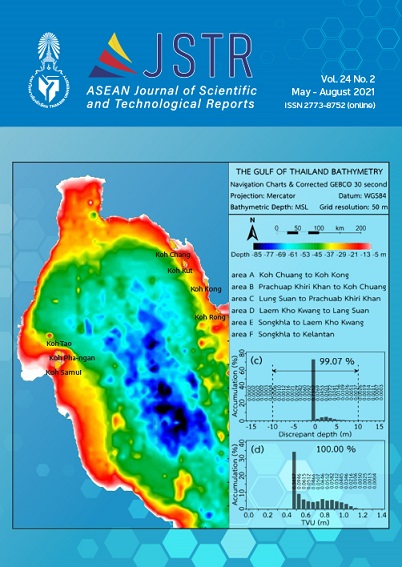Isolation and Optimization of Lipase Producing Bacteria from Oil-Contaminated Soils
Main Article Content
Abstract
This research aimed to isolate lipase-producing bacteria from soil samples contaminated with vegetable oil or petrol, and then optimize the conditions for lipase production. The bacteria that could be grown on tributyrin agar supplemented with 1% palm oil and produced a wide clear zone were selected. These selected bacterial isolates were tested for lipase activity, among them, the isolate PKRU-9 had the highest lipase activity. Then, the optimum conditions for lipase production of the PKRU-9 were optimized. The maximum lipase production was obtained when PKRU-9 was cultured in a basal medium containing 0.5% yeast extract as a nitrogen source and 0.5% soybean oil as a carbon source at 200 rpm. After cultivation for 54h, the maximum lipase production was reached. Treatment of wastewater contaminated with lipid of PKRU-9 was studied by culturing the bacterium in synthetic wastewater medium containing 1% palm oil, and in wastewater contaminated with fat. PKRU-9 was able to decrease the value of BOD5 by 74% and 90%, respectively comparing to the starting BOD5. The highest percent reduction of BOD5 was found on day 3 of cultivation. These results suggested that the PKRU-9 has the potential to be used for treating municipal wastewater contaminated with fat.
Article Details

This work is licensed under a Creative Commons Attribution-NonCommercial-NoDerivatives 4.0 International License.
References
Gupta, R., Gupta, N., & Rathi, P. (2004). Bacterial lipases: An overview of production, purification and biochemical properties. Applied Microbiology and Biotechnology, 64(6), 763–781.
Bharathi, D., Rajalakshmi, G., & Komathi, S. (2019). Optimization and production of lipase enzyme from bacterial strains isolated from petrol spilled soil. Journal of King Saud University - Science, 31(4), 898–901.
Supakdamrongkul, P., Prasong, P., & Gitram, K. (2015). Utilization of vegetable oil production waste for lipase production from Pseudomonas sp. HCU2-1 and enzyme characterization. Huachiew Chalermprakiet Science and Technology Journal, 1(1), 42–59.
Ilesanmi, O. I., Adekunle, A. E., Omolaiye, J. A., Olorode, E. M., & Ogunkanmi, A. L. (2020). Isolation, optimization and molecular characterization of lipase producing bacteria from contaminated soil. Scientific African, 8, e00279.
Salihu, A., Alam, M. Z., AbdulKarim, M. I., & Salleh, H. M. (2012). Lipase production: An insight in the utilization of renewable agricultural residues. Resources, Conservation and Recycling, 58, 36–44.
Mongkolthanaruk, W., & Dharmsthiti, S. (2002). Biodegradation of lipid-rich wastewater by a mixed bacterial consortium. International Biodeterioration & Biodegradation, 50(2), 101–105.
Chitpirom, K., & Sangaroon, P. (2012). Detection of lipolytic bacteria from environmental samples. Thai Journal of Public Health, 42(3), 3–18.
Dheeman, D. S., Henehan, G. T. M., & Frías, J. M. (2011). Purification and properties of Amycolatopsis mediterranei DSM 43304 lipase and its potential in flavour ester synthesis. Bioresource Technology, 102(3), 3373–3379.
Bradford, M.M. (1976). A rapid and sensitive method for the quantitation of microgram quantities of protein utilizing the principle of protein-dye binding. Analytical Biochemistry, 72(1), 248–254.
Matsumiya, Y., Wakita, D., Kimura, A., Sanpa, S., & Kubo, M. (2007). Isolation and characterization of a lipid-degrading bacterium and its application to lipid-containing wastewater treatment. Journal of bioscience and bioengineering, 103(4), 325–330.
Rungreang, O., & Pattanapipitpaisal, P. (2011). Treatment of lipid-contaminated wastewater by immobilised bacterial cell and immobilised lipase. In The 4th PSU Phuket research conference, 9. November16-18, 2011, Prince of Songkla University, Phuket campus.
Liu, C.-H., Chen, C.-Y., Wang, Y.-W., & Chang, J.-S. (2011). Fermentation strategies for the production of lipase by an indigenous isolate Burkholderia sp. C20. Biochemical Engineering Journal, 58- 59, 96–102.
Kamaladevi, B., Prabhavathi, P., Sankareswaran, M., Anbalagan, S., Radhakrishnan, N., & Prabhu, D. (2014). Screening and medium optimization of lipase producing bacteria from saltpan. Research Journal of Chemical and Environmental Sciences, 2(2), 72–77.
Ertuğrul, S., Dönmez, G., & Takaç, S. (2007). Isolation of lipase producing Bacillus sp. from olive mill wastewater and improving its enzyme activity. Journal of hazardous materials, 149(3), 720–724.
Gökbulut, A. A., & Arslanoğlu, A. (2013). Purification and biochemical characterization of an extracellular lipase from psychrotolerant Pseudomonas fluorescens KE38. Turkish Journal of Biology, 37(5), 538–546.


